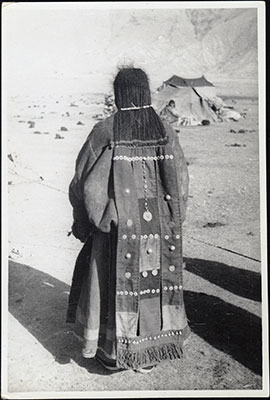
1998.131.246.1 (Print black & white)


1998.131.246.1 (Print black & white)

Frederick Spencer Chapman
Frederick Spencer Chapman
January 7th 1937
Lhasa Area
1998.131.246.1
161 x 109 mm
Print gelatin silver
Donated 1994
Faith Spencer Chapman
British Diplomatic Mission to Lhasa 1936-37
Frederick Spencer Chapman
BJ.33 In publication
'Lhasa Mission 1936, Diary of Events', P. Neame, H. Richardson, F. S. Chapman, Government of India Political Department [Note: photographs for October 18th - November 4th 1936 are not included as their relationship to text is not detailed; see Mission Diary text for details of images] [see photos in publication]
SC.T.2.246
BMR.86.1.43.2
'Lhasa Mission 1936, Diary of Events', P. Neame, H. Richardson, F. S. Chapman, Government of India Political Department [Note: photographs for October 18th - November 4th 1936 are not included as their relationship to text is not detailed; see Mission Diary text for details of images] [view list of illustrations]
Notes on print/mount - 'BJ 33' has been written on the back of the print in pencil. This relates to the numbering system that Chapman adopted for the images that he took whilst working as official photographer and Secretary to the British Mission to Lhasa in 1936-37 under Sir Basil Gould. [MS 10/2/2005]
Manual Catalogues - Caption in Chapman's hand-written list of negatives made whilst on the Mission to Lhasa, 1936-7 [See PRM Manuscripts Collection]: 'Full view of back of woman'; PRM Manuscripts Collection: ‘List of Tibetan Prints and Negatives’ - Book 4: ‘6/4 - Chang Tang herdswoman’s strange hair “do” ornamented with medallions and trouser buttons’ [MS 16/03/2006]
Contemporary Publication - This image was used to illustrate the Mission to Lhasa Diary entry for January 7th 1937. On that date Chapman rose early to travel to the outskirts of Lhasa to photograph some of the nomad groups that had come to the city to pay taxes and participate in the New Year festivities shortly to take place. In the Appendix to the Diary, Part XII, in which he gives captions for the images, he wrote the following for this image: "Head-dress of nomad woman from the Mongolian border". The main text in the Diary that this image illustrates is as follows: "The women, who are remarkably handsome, wear their hair in innumerable minute plaits which are attached at shoulder level to a multi-coloured piece of canvas which hangs down almost to the ground. This cloth is ornamented with silver buttons, Chinese dollars and other trinkets. Although we visited their tents at dawn many of the men had already set off with yak-loads of salt and yak-dung - representing their taxes - to be delivered at the Potala" [MS 26/3/2005]
Other Information - Description: Chapman wrote a further, fuller description of the dress and hair style of this particular woman in his publication Lhasa the Holy City [London: Chatto & Windus 1938; reprint, London: Readers Union Ltd., 1940]. He wrote: "Another head-dress [for prior reference see 1998.131.248 & 1998.131.249] was even more remarkable: the woman's hair was again tied into tiny plaits and these were sewn on to a long strip of cloth woven in green and scarlet squares that reaches almost to the ground. These squares were ornamented with Chinese dollars, Indian rupees, pieces of coral and turquoise, rows of cowrie shells and carved ivory; and in the centre was a beautifully embossed disc of silver. I wondered how often she washed her hair! Some women wear two lumps of amber as big as plums on top of their heads, and usually a few turquoises or corals between. Sometimes strips pf black, green, or scarlet cloth are sewn on to the border and sleeves of the sheep-skin garment. This is very effective" [1940, p.159] [MS 26/3/2005]
Other Information - Cultural Background: Generally Horpa women would have their hair in 108 plaits to reflect the 108 volumes of the Tripitika. The warp threads of the textile extensions would be woven into the hair. The extensions are very heavy because they are made of wool. On the back they would have a string made of precious stones with a round copper or brass charm, often referred to in Tibetan as melong or 'mirror' which is intended to ward of malevolent spirits; this has to be very clear and shiny. Previously they used to use cowrie shells but in this image they appear to be buttons made of conch shells; could also use rupees. The bottom row appears to be made of bells. The colours on the extensions would be natural dyes - often red/maroon, blue and yellow [TS 31/1/2005]
Other Information - Related Images: Images prefixed with 'BJ' comprise a group of negatives containing images of the Lhasa band, chang girls, Tibetan officials including Tsarong and Ringang, Finch, Norbhu, Everest Permit and Khampa people. They all seem to have been taken in the early part of January 1937. Chapman seems to have ventured beyond Lhasa to take photographs of nomad groups in the valley on January 7th 1937 [MS 16/03/2006]
Other Information - Related Images: 1998.131.244.1/2 - 1998.131.249 all appear to have been taken with the same group of people on the same occasion. This seems to have been January 7th 1936, on which date Chapman rose early to travel to the outskirts of Lhasa to take photographs of the various nomad communities that had travelled to Lhasa to pay taxes and participate in the New Year festivities, according to the Mission Diary. The man out of focus in the distance is actually the same man in 1998.131.244.1/.2 and 1998.131.245. He also is in the same posture. A closer view of this woman's hair is seen in 1998.131.247 [MS 10/2/2005]
For Citation use:
The Tibet Album.
"Horpa woman showing hair and textile extension"
05 Dec. 2006. The Pitt Rivers Museum.
<http://tibet.prm.ox.ac.uk/photo_1998.131.246.1.html>.
For more information about photographic usage or to order prints, please visit the The Pitt Rivers Museum.
© The Pitt Rivers Museum